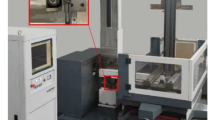Abstract
High-speed wire electrical discharge machining (WEDM-HS) of materials of super-high thickness (more than 1000 mm) is a challenging problem. First, sufficient energy is required to maintain the inter-electrode normal discharge. Next, there must be adequate inter-electrode dielectric fluid. Third, in order to generate a smooth cut surface, it is necessary to suppress the vibration of the wire electrode to reduce vibration lines on the cutting surface. To better understand these challenges, the energy and the flow of the medium between two electrodes were analyzed, allowing the establishment of a relevant model. The results indicated that for super-high-thickness machining, the pulse energy must be adequate to compensate for the energy consumed in the molybdenum wire and inter-electrode working liquid. In addition, the running speed of the wire electrode should be improved to ensure that there is a sufficiently high flow rate of the dielectric fluid. The servo control mode of the existing machine tools and dielectric fluid were improved and then a process experiment was performed. The experimental results show that the process can be carried out efficiently and stably and the workpiece surface can be cut smoothly using the improved working liquid and servo control mode.
Similar content being viewed by others
References
Fan YS, Li CJ, Bai JC, Li Q (2014) Experimental study on energy consumption of energy-saving pulse power for WEDM. Int J Adv Manuf Technol 72:929–934
Liu ZD (2006) Research on cooling liquid used in super-high thickness workpiece cutting of HS-WEDM. 1:25–27
Shi WT, Liu ZD, Qiu MB, Tian ZJ (2016) Wire tension in high-speed wire electrical discharge machining. Int J Adv Manuf Technol 82:379–380
Chakraborty S, Dey V, Ghosh SK (2015) A review on the use of dielectric fluids and their effects in electrical discharge machining characteristics. Precis Eng 40:1–6
Liu ZD (2005) Research on the general feature of emulations & dielectrics and its tendency in WEDM-HS. Aviat Precis Manuf Technol 41:38–42
Liu ZD, Wei W, Lu LY, Xu AY (2012) Research of relationship between interelectrode dielectric properties and energy distribution in wire electrical discharge machining. J Shanghai Jiaotong Univ 46:1015–1020
Wen BQ (2009) Handbook of metallic materials. Electronic Industry Press [M], Beijing
Ma QK (2009) Research on preparation and properties of cutting fluid for WEDM machine tool. Hebei University of Technology TG484:2-5
Liu ZD, Wang ZX, Li JJ, Cheng GZ (2009) Research on high speed wire-cut electrical discharge machine based on analysis of inter-electrode flow. Electromach Mould 4:52–55
Zhang YY (1986) Hydrodynamics. Higher Education Press [M], Beijing
Li MQ, Li MH, Xu GY (2005) Study on the variations of form and position of the wire electrode in WEDM-HS. Int J Adv Manuf Technol 25(9–10):929–934
Zhang WJ, Liu ZD, Qiu MB (2013) The experimental research on immersion fluid HS-WEDM process. Electromach Mould 3:50–54
Yu J, Di SC (2001) Research on micro-EDM pulse generator and strategy of servo control[J]. Electromach Mould 2001:8–9
Siva Kumar M, Sivakumar K, Shanmuga Prakash R, Vignesh S (2015) Parameters optimisation of wire electrical discharge machining on AISI D3 steel with different thickness. Int J Appl Eng Res, ISSN 0973-4562 10(62):185–190
Xiong GY, Li MQ, Li MH, Zhang JR, Hong FM (2002) An effective method on stabilizing the form and position of wire-electrode. Electromach Mould 2002(05):11–13
Li LL, Liu ZD, Li XF, Li MM (2014) Non-even wire tension in high-speed wire electrical discharge machining. Int J Adv Manuf Technol 78(1–4):503–510
Acknowledgements
We extend our sincere thanks to all who contributed in the preparation of these instructions.
Funding
This project is supported by the National Natural Science Foundation of China (Grant No. 51575271) and Open Research Fund of Key Laboratory of High Performance Complex Manufacturing, Central South University (No. Kfkt2015-04).
Author information
Authors and Affiliations
Corresponding author
Rights and permissions
About this article
Cite this article
Li, C., Liu, Z., Fang, L. et al. Super-high-thickness high-speed wire electrical discharge machining. Int J Adv Manuf Technol 95, 1805–1818 (2018). https://doi.org/10.1007/s00170-017-1246-5
Received:
Accepted:
Published:
Issue Date:
DOI: https://doi.org/10.1007/s00170-017-1246-5



